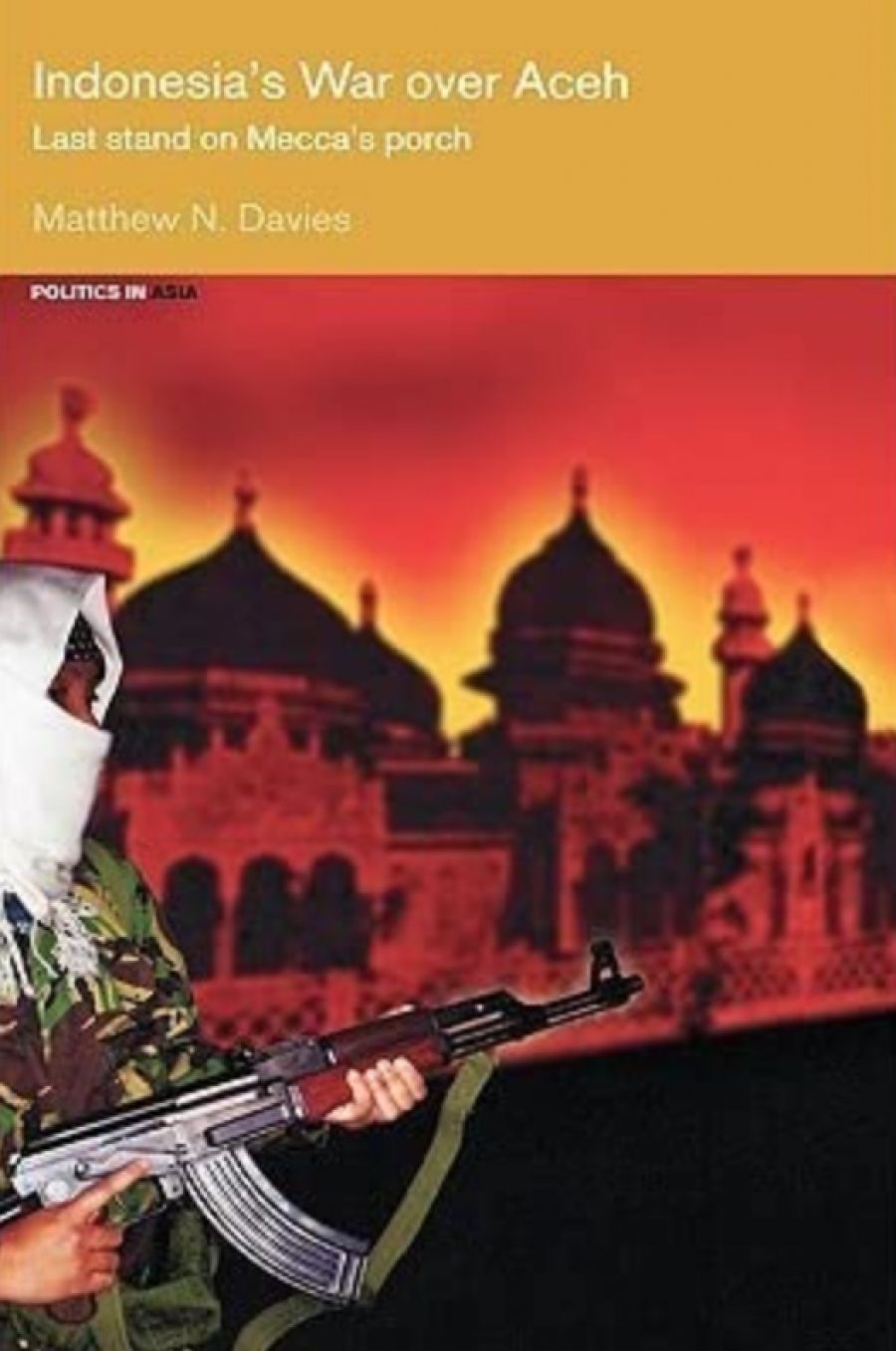
- Free Article: No
- Contents Category: International Studies
- Review Article: Yes
- Online Only: No
- Custom Highlight Text:
The intrinsic quality of a state is, in the final instance, determined by that which guarantees its claim to authority. In the case of Indonesia, such guarantee is its military, the Tentara Nasional Indonesia (TNI), while the rebellious, resource-rich province of Aceh has arguably been the site of its most concerted effort. At a time when Western political leaders and most Indonesia scholars champion Indonesia’s procedural democracy, despite a reduced political capacity, the TNI structurally remains the institution that it was. As a result, studying the role of the TNI in Aceh reveals critical insights into continuing aspects of the Indonesian state.
- Book 1 Title: Indonesia’s War Over Aceh
- Book 1 Subtitle: Last stand on Mecca’s porch
- Book 1 Biblio: Routledge, £65 hb, 308 pp
- Book 1 Readings Link: booktopia.kh4ffx.net/y0ny2
Matthew Davies, a former military intelligence analyst, was interested in both the TNI and in Aceh, and disappointed with much of what had been written on both. This is made clear in his carefully researched study, Indonesia’s War over Aceh: Last Stand on Mecca’s Porch. Davies’ book sits between the various studies on the TNI, but is more detailed and specifically focused than most, and differs from most studies of Aceh. Aceh deeply influences Davies’ study, primarily because it provided a particular context for otherwise standardised TNI responses.
Two ‘targets’ of Davies’ book are established upfront. The first target is the authors of much existing work on both the TNI and Aceh, which he characterises as risking ‘the appearance of tourist indulgence’ or reflecting ‘uncritical tendencies and dependency on judiciary-style precedent of peer discourse, to cascade error, obfuscation, or ethno-caricature’. Davies’ second target is the widespread misperception surrounding ‘intelligence’, the politicised terminology of which he describes as ‘internal double-speak, inexcusable and technically nonsensical’. Few authors on either the TNI or Aceh escape unscathed, though the intelligence community’s interlocutors are spared extended criticism.
Davies’ writing style is informed by his use of open-source intelligence, or information that is publicly available but carefully assembled and analysed. Though his source information may be public, if almost entirely in the Indonesian language, the analytical method is pure ‘intel’. His writing style is, consequently, solid going. Even for one who is familiar with most of the terms and symbols used, the breadth of detail can be overwhelming. To assist, Davies offers a list of acronyms and common terms, as well as descriptions of basic military symbols. This is valuable but may necessitate frequent reference checks for those less familiar with the subject. A more narrative writing style would have been more inviting, but Davies’ concentration on detail does show that he has done his homework, solidly counters competing claims, and remains an excellent resource for other researchers.
The first part of the book assesses how the TNI operated in Aceh, describing the Aceh ‘battlespace’ and the local organisation of the TNI. The reader is struck by the TNI’s own references to Dutch methods, which eventually succeeded, but at a cost that nearly crippled the Dutch state, and which left a scar upon its post-colonial psyche.
While much of the detail presented here is dense, Davies does a good job summarising at strategic points. The TNI, he accurately notes, ‘led the world for its relative impenetrability of inventiveness, inconsistency and contradictions, tautology and permutations’. This is all made easier to understand as Davies reveals what soldiers actually do and how their actions inform their organisation in reality, as distinct from their formal structure.
The second part of the book considers how the TNI actually fared, showing that, as the colonial Dutch comprehensively learned, soldiering in Aceh was a dangerous business. No doubt many other Indonesians would regard Aceh as the Dutch did, had the TNI not been so adroit at ‘perception management’. In a classic case of doublespeak (or uncharacteristic irony), Davies notes one newspaper headline from the height of military operations in 2003 as ‘Peace in Aceh’. The final three chapters are the most gripping. Davies examines institutionalised human rights abuses, militias (familiar to many Australians from East Timor) and the role of Islam in this most devoutly Islamic of provinces. He segues into a brilliant extrapolation on the ‘shadow war’ of spies, psychological operations and terrorism. Among Davies’ many research skills is his ability with diagrams and maps. The diagram presented on page 212 is the clearest and most thorough outline yet of links between shadow and non-GAM Islamist organisations, Jema’ah Islamiyah, al Qaeda and TNI intelligence. In this ‘age of terror’, it is disturbing reading.
Davies concludes with a brief account of misrepresentations of the Acehnese people around the time of the 2004 Boxing Day tsunami, which took 180,000 lives in the region. The subsequent peace process is, reasonably, outside this study’s scope.
Davies’ book may be primarily intended for an audience specifically interested in Indonesia, and particularly the TNI and Aceh, but it will also attract readers interested in more general militaria. At this price it is not an obvious purchase, but one would expect that Indonesia’s War over Aceh will be quickly added to, and sought from, the shelves of the world’s university and military college libraries.


Comments powered by CComment